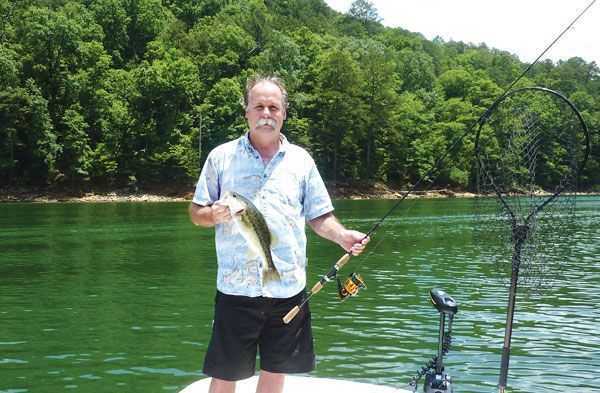
A Drop-Shot Primer For Your Bass-Fishing Arsenal
By Jenny Crowley:
Over the last decade, drop-shot or down-shot fishing has proven itself time and again as one of the most effective ways to target finicky fish. Especially during the summer and winter months, when bass are deep and packed tightly on open-water structure, the finesse approach of a drop shot may be the best way to consistently catch difficult fish.
Some say it came from Japan, where tournament anglers adapted it for use on heavily pressured lakes. The technique is also very similar to those used by saltwater anglers targeting lethargic or suspended fish. Wherever it came from, drop-shotting exploded onto the U.S. bass tournament scene in the late 1990s when pros used it with great success on deep western lakes. Since then, the drop-shot has gained a foothold nationwide.
Even so, many anglers, even tournament guys, still do not include a drop-shot rig in their bag of tricks. The following is a drop-shot primer for those of you who still haven’t gotten with the program.
Although there are many different ways to set up and fish this rig, the keys to success are proper equipment and a finesse approach. Start with a 6 ½- to 7-foot medium-action spinning rod spooled with 10-pound braided line. The braided line helps to eliminate line twist. The next step is to tie in a swivel. A 50-pound SPRO Micro Swivel is a good choice. Cut a 5-foot piece of fluorocarbon leader and tie it to the open end of the swivel. Next, using a palomar knot and leaving a long tag end at the hook, tie on a 1/0 or 2/0 hook (a Gamakatsu Finesse Wide Gap is a good one). Lastly, depending on water current, wind and depth, tie on a 3/16- to 3/8-ounce Tungsten drop-shot weight to the tag end. Now the rig is ready for the next crucial element, bait.

As all anglers know, the options for plastics are endless. First one must determine the target species and then choose appropriate colors and sizes. Keep in mind that water clarity plays a significant role when choosing colors that will yield the best results. In clear waters, the most productive colors are natural: albino, white peal, silver or shad. For those anglers fishing in stained waters, opt for green, pumpkin seed or watermelon. Once the colors have been chosen, one must choose a size. Whether the target species is spotted bass, smallmouth bass or largemouth, it’s wise to be prepared with a variety of sizes. For small baits, Zoom Tiny Flukes and 3-inch Berkley Gulp Baitfish are excellent choices. For medium and large baits, try a Zoom Super Fluke Jr., a Zoom Super Fluke, a 4-inch Berkley Mud Minnow or a 5-inch Berkley Gulp Shad. Hook the bait of choice through the very tip of the nose, just enough to hold the soft plastic on the hook.
Now that the gear is ready to go, it’s time to do what every angler looks forward to the most. Get on the water and execute the plan. Look for humps, long points, bends in creek channels and structure like rockpiles, brushpiles and fish attractors. Once the structure has been located, deploy the trolling motor and adjust your depthfinder. By only fishing in “the zone,” the angler can slow down and concentrate in a specific, productive area.

Turn up the sensitivity on the sonar to almost max. Remember that drop-shotting is a vertical presentation. In many cases, the angler will be watching the fish on the graph and targeting them directly. Increase the chart speed to just under max. Switch to a view where both the GPS and down sonar show simultaneously on the screen. Now, use the trolling motor to move around the target structure and mark fish on the GPS. After fish have been marked, drop the drop-shot rig to the bottom and start jigging while watching the sonar. Get a visual on the newly dropped bait moving up and down. Lastly, decrease the sensitivity on the sonar until the screen clutter disappears yet the dropped bait is still visible.
The gear is ready, structures are located, fish are marked and sonar sensitivity has been finely tuned; it’s time to fish. Get as close to the structure as possible. When working the drop-shot rig, keep the weight on the bottom at all times. Lift the rod tip 6 to 8 inches to give the bait a dancing motion while keeping it in the strike zone. Be sure to keep the rod tip moving in a constant twitching motion. It’s important to keep in mind that this is a live baitfish imitation. It is not a slow-crawling-on-the-bottom type system. Stay patient and develop a finesse that makes this technique work for you. Also, keep a watchful eye on the sonar. It’s always exciting to see a fish that takes an interest the bait.
Drop-shot fishing is productive year round. Warm and cold water, wind and even post-frontal conditions are not a deterrent for this rig. In the South, the most plentiful catches occur May-September, after the spawn when the water is warmer and the fish are on structure aggressively feeding on baitfish.
If you’re not already using a drop shot to ramp up your productivity on the water, give it a try. This technique will provide results, just as it has for saltwater anglers and professional bass fishermen targeting deep, difficult fish for decades.
Jenny Crowley is an avid angler and the wife of Eric Crowley, of Lake & Stream Guide Service, which offers full-service guide trips for all species on north Georgia lakes and rivers.
[easy-social-share]